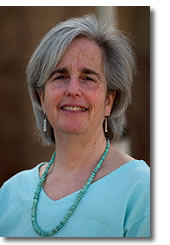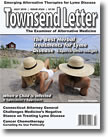Healthcare Reform Expands Our Choices
The landmark healthcare reform legislation passed by Congress increases support for prevention and wellness programs. It will expand our ability to access a wide range of healthcare services, and specifically includes the CAM (complementary and alternative medicine) professions as part of the healthcare workforce. We will see a high-level council for health promotion that could take essential steps toward preventing chronic disease.
However, passing the legislation is only the beginning of what will certainly be a long process. Over the next months, the Department of Health and Human Services (HHS) will draft rules to specify exactly what the legislative language means in practice. For those who believe that the entire healthcare system needs to shift from isolated remedies for diseases towards whole-systems approaches to prevent disease, this legislation is a hopeful first step, but just the first step.
The law defines the term "healthcare workforce" to include "all healthcare providers with direct patient care and support responsibilities," and specifically mentions licensed CAM providers, integrative health practitioners, doctors of chiropractic, and certified nurse midwives.
 "This change is huge but incomplete," says Janet Kahn, PhD, executive director of the Integrated Healthcare Policy Consortium (IHPC). "It puts integrated healthcare more prominently in the public mind and discourse. Yet, when speaking of medical homes the inclusion of integrated healthcare practitioners is encouraged, but not backed by financial resources nor a mandate that specific types of professionals should be employed. Still, this redefinition is a real statement about who is part of our healthcare workforce. It puts the Department of Labor on notice that when they report on the healthcare workforce, from now on they need to report on all licensed complementary and alternative medicine professionals." "This change is huge but incomplete," says Janet Kahn, PhD, executive director of the Integrated Healthcare Policy Consortium (IHPC). "It puts integrated healthcare more prominently in the public mind and discourse. Yet, when speaking of medical homes the inclusion of integrated healthcare practitioners is encouraged, but not backed by financial resources nor a mandate that specific types of professionals should be employed. Still, this redefinition is a real statement about who is part of our healthcare workforce. It puts the Department of Labor on notice that when they report on the healthcare workforce, from now on they need to report on all licensed complementary and alternative medicine professionals."
The legislation says that health plans and health insurers "shall not discriminate with respect to participation under the plan or coverage against any healthcare provider who is acting within the scope of that provider's license or certification under applicable State law." However, insurers are allowed to establish variations in reimbursement rates, and they are not required to contract with any willing provider.
"To me, this gives us a place to begin," Kahn says. "It means you're not supposed to discriminate against whole classes of providers. At this time, such discrimination is rampant – both within private insurance and in government programs. Now we need to pay close attention to the rulemaking process."
Many detailed federal regulations will be needed to support the health-care legislation. HHS will issue proposed rules, and then there will be several weeks for public comments on each rule. Letters and other responses from interested parties and the general public will influence the final shape of the regulations, and the eventual impact of healthcare reform.
High-Level National Council Will Promote Health and Wellness
Last year the Samueli Institute, in collaboration with the Integrated Healthcare Policy Consortium and other health-care policymakers, leaders, and researchers, developed the Wellness Initiative for the Nation (WIN), which outlined ways that the US could move towards effective disease prevention and long-term health promotion. It called for a White House Office focused on health promotion and wellness.
The reform legislation that actually passed creates a National Prevention, Health Promotion and Public Health Council to coordinate federal prevention and wellness activities. This council will be part of the HHS; it will be chaired by the surgeon general. Its members include the secretaries of HHS, Agriculture, Education, Transportation, Labor, and Homeland Security. Clearly, this will be a top-level organization with the ability to coordinate a wide range of activities.
 "The advantage of having a health promotion council within HHS is that it has more stability than a White House office," notes Matthew Fritts, MPH, senior program manager at the Samueli Institute. "It will not be subject to changes of administration. While the council is housed within HHS, it will include leadership that spans the various federal departments. " "The advantage of having a health promotion council within HHS is that it has more stability than a White House office," notes Matthew Fritts, MPH, senior program manager at the Samueli Institute. "It will not be subject to changes of administration. While the council is housed within HHS, it will include leadership that spans the various federal departments. "
In addition, the council will be supported by an Advisory Group on Prevention, Health Promotion, and Integrative and Public Health, composed of experts in worksite health promotion, preventive medicine, health coaching, and community health. The legislation specifically states that the advisory group will include "a diverse group of licensed health professionals, including integrative health practitioners."
"However, it remains to be seen how this will be operationalized," Fritts says. "Members of the council and advisory group are due to be selected by July 1. Specific recommendations, goals and objectives will be developed and documented along with action plans and timelines in a National Prevention, Health Promotion and Public Health Strategy, due in one year."
Kahn sees the council as a way to move toward a society that actively promotes health. "We need to move towards an integrated healthcare policy," she says. "That means that federal and state policies should try to align incentives so they point people towards health and well-being. You don't want to have one department working to prevent the damaging effects of child obesity, while another department subsidizes corn production for high-fructose corn syrup, used in half the products children consume daily."
Prevention Includes Much More Then Screening
During December 2008, the Obama-Biden Transition Health Policy Team hosted more than 8000 community-based discussions on health-care policy. Their suggested outline of topics included three examples of preventive services: mammography, flu shots, and cholesterol screenings.
From a holistic point of view, prevention should include far more than immunizations and early detection of disease. Prevention, broadly understood, should mean offering people the tools, information, and environment that will help them minimize disease and maintain vibrant health.
Wayne B. Jonas, MD, president and CEO of the Samueli Institute, presented the key issue clearly in June 2009, when he testified before the Senate Committee on Health Education, Labor and Pensions. "We know what factors will prevent disease and enhance function for 70% of chronic illnesses," he said. He listed several important issues, including:
- proper substance use (no smoking, plus appropriate alcohol, drugs, diet, and environmental chemicals);
- adequate exercise and sleep;
- stress and resilience management;
- social integration and support; and
- selective disease screening and immunization.
"We also know that health and illness are a continuum," Jonas added. "Those factors noted above will prevent disease long before it is diagnosed and improve function long after disease develops. It is no longer rational nor scientifically sound to wait until disease reaches an advanced diagnostic threshold, and then provide expensive late-stage interventions."
The healthcare reform legislation includes increased coverage for preventive services. There will be grants for small employers who establish wellness programs. Employers will be able to offer financial rewards for employees who participate in wellness programs.
However, this is clearly another area in which the detailed rules that describe and define these programs will be of critical importance.
Mobilizing for the Next Steps
The Samueli Institute is a nonprofit research organization that aims to transform health care through the scientific investigation of healing. IHPC is an advocacy organization, working towards a health-oriented, integrated healthcare system.
Over the past year, IHPC has broadened its reach, developing what it calls the Online Action Network. This Web-based communication system allowed health-care practitioners and consumers to mobilize throughout the health-care reform debate, using modern tools to reach legislators at key moments. "We launched the Online Action Network just last summer, and it is growing rapidly." Kahn says. "Our people sent thousands of letters while the healthcare reform bill was being written, addressing issues from expanding patient choices about the providers they can see, to urging the Congressional Budget Office to develop sophisticated models to examine cost savings from preventive care. We trust those letters were one factor in shaping the final bill."
Over the past few years, IHPC has been a quiet presence in Washington, operating primarily within the public policy arena. However, during 2009, the organization created the Online Action Network in response to widespread needs. "As I spoke on policy panels at health conferences, I saw there was an incredible hunger on the part of CAM providers and patients, to have a direct voice on Capitol Hill," Kahn says. "Now, when we speak before legislative committees, those committees know that we represent thousands of informed and engaged citizens, and the millions of quiet ones that the activists always represent."
During 2010, IHPC is restructuring itself to strengthen the role of other healthcare and consumer organizations in setting its agenda. Organizations such as Bastyr University, the American Massage Therapy Association, and the American Association of Acupuncture and Oriental Medicine have joined an IHPC alliance called Partners for Health, and they have seats on the IHPC board of directors.
"Consortium is in our name," says Kahn. "We have always been about collaboration. The non-discrimination language in this healthcare reform bill is, at least in part, a result of letters of support from over 20 conventional and alternative health associations and educational institutions that we pulled together representing nurses, audiologists, family therapists, acupuncturists, chiropractors, naturopathic doctors, and more."
Kahn envisions an enhanced and increasingly effective presence on Capitol Hill in future years.
"Our restructuring offers organizations that want it a true role in setting IHPC's policy agenda," she says. "We all benefit when we go to Capitol Hill with the combined force of all our organizations, in service to our shared goals."
Resources
The Integrated Healthcare Policy Consortium: www.ihpc.info.
For the IHPC Online Action Network: http://capwiz.com/ihpc/home.
The Samueli Institute: 703-299-4800; www.siib.org.
For a copy of the Wellness Initiative for the Nation proposal: http://www.samueliinstitute.org/news/news-home/WIN-Home.html.
For a summary of the health reform legislation: http://www.kff.org/healthreform/8061.cfm.

Elaine Zablocki has been a freelance healthcare journalist for more than 20 years. She was the editor of Alternative Medicine Business News and CHRF News Files. She writes regularly for many healthcare publications. |



![]()
![]()
![]()

 "This change is huge but incomplete," says Janet Kahn, PhD, executive director of the Integrated Healthcare Policy Consortium (IHPC). "It puts integrated healthcare more prominently in the public mind and discourse. Yet, when speaking of medical homes the inclusion of integrated healthcare practitioners is encouraged, but not backed by financial resources nor a mandate that specific types of professionals should be employed. Still, this redefinition is a real statement about who is part of our healthcare workforce. It puts the Department of Labor on notice that when they report on the healthcare workforce, from now on they need to report on all licensed complementary and alternative medicine professionals."
"This change is huge but incomplete," says Janet Kahn, PhD, executive director of the Integrated Healthcare Policy Consortium (IHPC). "It puts integrated healthcare more prominently in the public mind and discourse. Yet, when speaking of medical homes the inclusion of integrated healthcare practitioners is encouraged, but not backed by financial resources nor a mandate that specific types of professionals should be employed. Still, this redefinition is a real statement about who is part of our healthcare workforce. It puts the Department of Labor on notice that when they report on the healthcare workforce, from now on they need to report on all licensed complementary and alternative medicine professionals."  "The advantage of having a health promotion council within HHS is that it has more stability than a White House office," notes Matthew Fritts, MPH, senior program manager at the Samueli Institute. "It will not be subject to changes of administration. While the council is housed within HHS, it will include leadership that spans the various federal departments. "
"The advantage of having a health promotion council within HHS is that it has more stability than a White House office," notes Matthew Fritts, MPH, senior program manager at the Samueli Institute. "It will not be subject to changes of administration. While the council is housed within HHS, it will include leadership that spans the various federal departments. " 